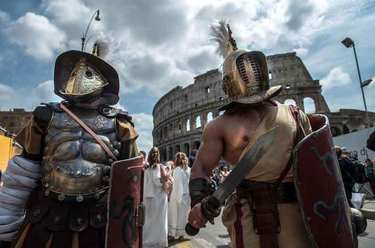 Rome is getting old. In April, Romans celebrate its 2,769th birthday. (Complaining about catching up to the Beatles song, "When I'm 64" is a little ridiculous when compared to Rome's age). Every year in April, Rome celebrates its old age with parades and other events all around the city. One of the symbols of the Eternal city is the bronze she-wolf and symbol of Rome "Lupa Capitolina" which is now at the Capitoline museum. Rome's history begins with a legend of love, lust, jealously and murder almost three thousand years ago. The pagan god Mars, smitten by the beauty of a Vestal Virgin, made his way into her temple to sleep with her. When the disgraced Vestal gave birth to twin boys, remarkable for their size and beauty, the evil tribal king ordered the infants thrown in the Tiber River. The cradle containing the babies drifted downstream and washed ashore at the base of the Palatine hill, named for Pale, a goddess of shepherds. There, according to legend, a lupa (she-wolf) suckled the twins Romulus and Remus. Historians think the nursing wolf was more than likely a human woman--in Latin, the word Lupa was slang for prostitute, and brothels were known as lupanaria. During ongoing excavations on the Palatine hill, archaeologists recently discovered what could be the original lupercale, the cave that sheltered the twin boys and that later served as a shrine for their worship. As the boys grew, they were instrumental in building a small town on the banks of the Tiber. The Italian capital's official founding date is 21 April. On that date, according to the legend, the brothers got into a terrible argument over their town, and Romulus killed his brother Remus in order to declare himself both ruler and founder. Obviously pleased with himself (and, apparently, his recent murder of his brother), he named the new city after himself. Egotistical guy, huh? Archaeological research and discoveries suggests the date of the beginnings of Rome is roughly correct. They estimate that the area had actually been populated since about 1000 BC, but 753 BC symbolically and officially marks the beginning of the Rome we still see ruins of today. Since then, the city's had a fairly volatile trajectory: first a small Latin village, then capital of a giant Mediterranean empire, then a bit of a ghost town dominated by the Pope, before finally becoming capital once again of a reunited Italy in the 19th century. As the graph shows, the city's population grew dramatically over time. Look at the dip during the Fall of the Roman Empire at 476 AD and its growth after the late 1800s brought unification to Italy:  The Roman roots are still at the core of modern day Rome---even the man hole covers, emblazoned with S.P.Q.R., the ancient Latin abbreviation for the Senatus Populusque Romani (the senate and people of Rome). Modern day Romans insist that the letters really stand for Sono pazzi questi Romani. (They're crazy, these Romans). Buon compleanno, Roma! --Jerry Finzi Please, stop by our SURVEY and spend 60 seconds telling us how we could make our blog better! Grazie! You can also follow Grand Voyage Italy on: Google+ StumbleUpon Tumblr
0 Comments
Your comment will be posted after it is approved.
Leave a Reply. |
Categories
All
Archive
June 2024
|






 RSS Feed
RSS Feed
